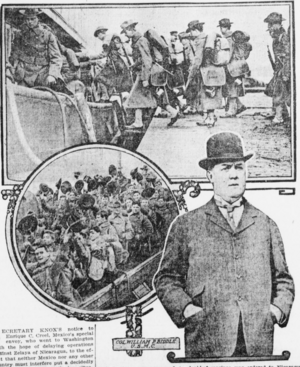José Santos Zelaya facts for kids
Quick facts for kids
Jose Santos Zelaya
|
|
|---|---|
 |
|
| President of Nicaragua | |
| In office 25 July 1893 – 21 December 1909 |
|
| Vice President | Anastasio J. Ortiz 1893–1894 Francisco Baca 1894–1896 |
| Preceded by | Joaquín Zavala (Acting) |
| Succeeded by | José Madriz (Acting) |
| Personal details | |
| Born |
José Santos Zelaya López
1 November 1853 Managua, Nicaragua |
| Died | 17 May 1919 (aged 65) New York City, U.S. |
| Political party | Democratic Party |
José Santos Zelaya López (born November 1, 1853, in Managua, Nicaragua – died May 17, 1919, in New York City, USA) was an important leader in Nicaragua. He served as the President of Nicaragua from July 25, 1893, until December 21, 1909.
Contents
Early Life of José Santos Zelaya
José Santos Zelaya was born in Managua, the capital city of Nicaragua. His father was José María Zelaya Irigoyen, who came from Olancho, Honduras. His mother was Juana López Ramírez.
Zelaya's Political Reforms
As a member of Nicaragua's Liberal party, President Zelaya brought many new ideas to the country. He started several progressive programs to make life better for Nicaraguans. These included improving public education so more children could go to school.
He also worked on building more railroads and setting up steam ship lines. These changes helped people travel and move goods around the country more easily.
President Zelaya also put in place new rules to protect people's rights. These rules included equal rights for everyone and guarantees for property ownership. He also made voting mandatory and education compulsory for children. His government also worked to protect arts and industry and ensure different groups had a voice.
National Sovereignty and Foreign Relations
Zelaya strongly believed that Nicaragua should be independent and control its own future. This idea, called national sovereignty, sometimes caused problems with foreign countries. He often made decisions that were not popular with foreign investors who wanted to do business in Nicaragua.
In 1894, Zelaya used military force to take control of the Mosquito Coast. This area had been a source of disagreement for a long time. The British Empire claimed it as a protectorate, meaning they protected the native people living there. However, Nicaragua had always said the Caribbean Coast belonged to them.
The British had supported some local groups who wanted to create an independent, English-speaking area. But Zelaya's strong actions worked. The United Kingdom decided not to fight over this distant land and recognized Nicaragua's control. This land was very important because it was part of the "Vía del Tránsito" (Route of Traffic). This route connected the Caribbean Sea to the Pacific Ocean through the San Juan River and Lake Nicaragua. At that time, the Panama Canal did not exist, so this route was very valuable for trade and travel.
United States Involvement in Nicaragua
During Zelaya's time, there was a rebellion against his government. Some rebels were captured, and a few United States volunteers were among them. These volunteers faced severe consequences, which led to a serious disagreement between the U.S. and Nicaragua. This disagreement eventually led to the U.S. getting involved in Nicaragua.
In December 1909, U.S. Marines arrived in Nicaragua's Bluefields port. They created a neutral zone there to protect foreign citizens and their property. This zone also became a base for the rebels who were against Zelaya.
On December 17, 1909, President Zelaya decided to step down from power. He handed over control to José Madriz and then left Nicaragua for Spain. Madriz tried to continue fighting the uprising. However, in August 1910, a U.S. diplomat named Thomas Dawson helped the government agree to a surrender, and Madriz withdrew.
After this, the U.S. encouraged the people of Nicaragua to have a say in their government. A special meeting was called to write a new constitution for Nicaragua. The presidency was then filled by several Conservative politicians, including Adolfo Diaz. During this period, the U.S. influenced Nicaragua's growth and development through free trade and loans.
Zelaya's Family Life
José Santos Zelaya had a son named Alfonso Zelaya. Alfonso was named after the King of Spain. He studied in Europe before his father sent him to America to join the military. Alfonso graduated from West Point, a famous military academy, in 1910. He served in the U.S. Army for four years, including during World War I. In 1911, he married Marguerite Lee, who was American and a grandniece of General Robert E. Lee. They had a son named José Santos, after his grandfather.
Alfonso Zelaya's Music and Acting Career
Alfonso Zelaya was a talented pianist. He played with well-known groups like the San Francisco and Minneapolis symphony orchestras. He knew over 300 classical music pieces. He didn't just play in concert halls; he also enjoyed bringing classical music to vaudeville shows. Vaudeville was a type of entertainment with different acts, like music, comedy, and dance.
According to a newspaper from 1932, Alfonso was very friendly and had a good sense of humor. He could make vaudeville audiences enjoy classical music and always left them wanting more.
Starting in 1933, Alfonso also appeared in movies. He played small roles in many films. He is perhaps best known for his role in a 1942 short film called “What’s the Matador?” In this film, he played a Mexican character who gives confusing directions in Spanish to the Three Stooges. His last movie role was in 1952, where he played a piano player named "Gimpy" in the film Macao. Alfonso Zelaya passed away in North Hollywood on December 14, 1951.
See also
 In Spanish: José Santos Zelaya para niños
In Spanish: José Santos Zelaya para niños


